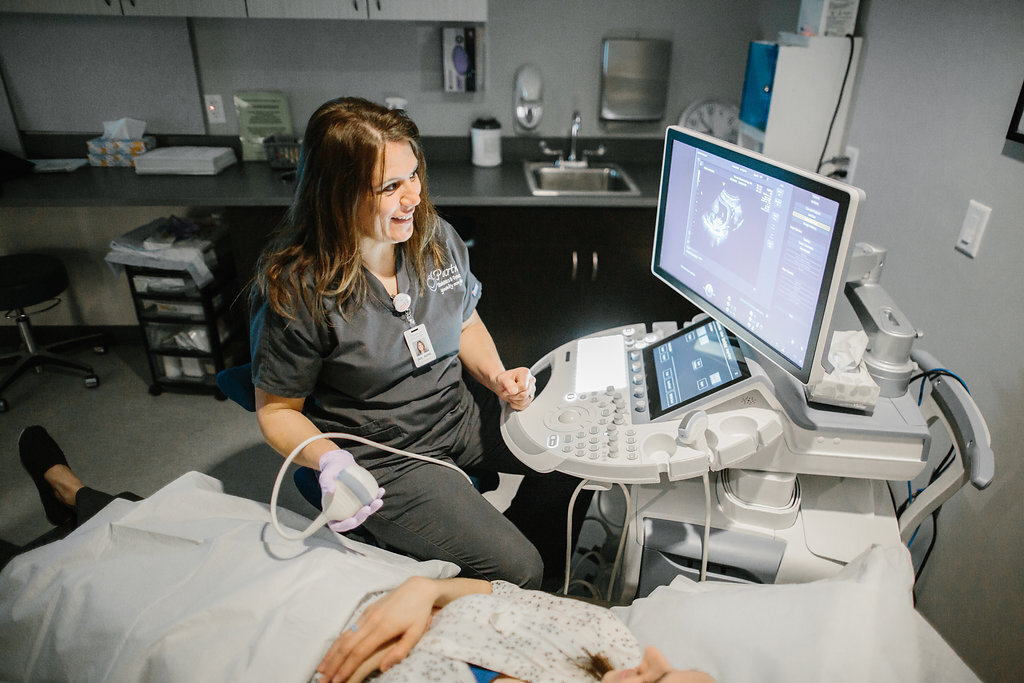An ultrasound is a wonderful piece of technology that can give parents a first look at their developing baby, but the tool can also provide a lot of helpful information about the health of a women’s reproductive system. In today’s blog, we take a closer look at some of the health conditions that can be seen on an ultrasound.
Ultrasound technology is a safe imaging technique that relies on sound waves to produce an image of the scanned area. The ultrasound transducer sends out high frequency sound waves over an area. These sound waves travel into the examined area until they hit a boundary between tissues, like fluid, soft tissue or bone. These sound waves bounce off different tissues and are reflected back to the machine, which quickly interprets the speed, direction and distance the sound waves travel in order to create a two-dimensional rendering on a computer screen.
Besides helping expecting couples see their developing baby, ultrasound can help detect the presence of these women’s health issues:
-
Uterine Fibroids – An ultrasound can pick up the presence of uterine fibroids, which are noncancerous growths that develop in the uterus. They can help detect the size, shape, location and quantity of fibroids in the uterus, which can also help to dictate appropriate treatment methods.
-
Ectopic Pregnancy – One of the first things your provider will look for during the initial ultrasound is the presence of the fertilized egg. If the fertilized egg has implanted in the fallopian tubes, the pregnancy will unfortunately not be viable. You can learn more about ectopic pregnancies on this blog we dedicated solely to the topic.
-
Ovarian Cysts – An ultrasound is commonly used to diagnose and assess ovarian cysts, which are fluid-filled sacs that can develop on the ovaries. Similar to uterine fibroids, an ultrasound can help detect the size, shape and location of cysts on the ovaries.
-
PCOS – PCOS stands for polycystic ovary syndrome, which is categorized by the presence of multiple ovarian cysts that can contribute to fertility problems, weight gain and hormonal issues.
-
Endometriosis – An ultrasound can also be used to spot the signs of endometriosis, which is a condition where endometrial tissue that typically lines the uterine wall ends up growing outside the uterus. Endometriosis can cause chronic and painful inflammation outside the uterine cavity, lead to fertility issues and bleeding between periods. For more information about endometriosis diagnosis and treatment, head over to this page.
-
Adenomyosis – Adenomyosis is a rare condition in which the tissue that lines the uterus grows into the muscular wall, which can oftentimes contribute to menstrual issues including heavy bleeding or prolonged periods. Patients with adenomyosis also sometimes report bloating, cramping or pain during intercourse. Ultrasound can be used to detect this abnormal tissue growth.
-
Pelvic Congestion Syndrome – Finally, an ultrasound can be used to diagnose pelvic congestion syndrome, which is categorized by pelvic pain as a result of enlarged or varicose veins in the pelvis. It’s more common in women who have had multiple pregnancies or those with a history of blood clots. An ultrasound can be a noninvasive way to assess the health of veins in the pelvic region.
For more information about any of the above conditions, or to talk with a provider about a women’s health issue you’re experiencing, reach out to the team at MetroPartners OBGYN today at (651) 770-3320.

